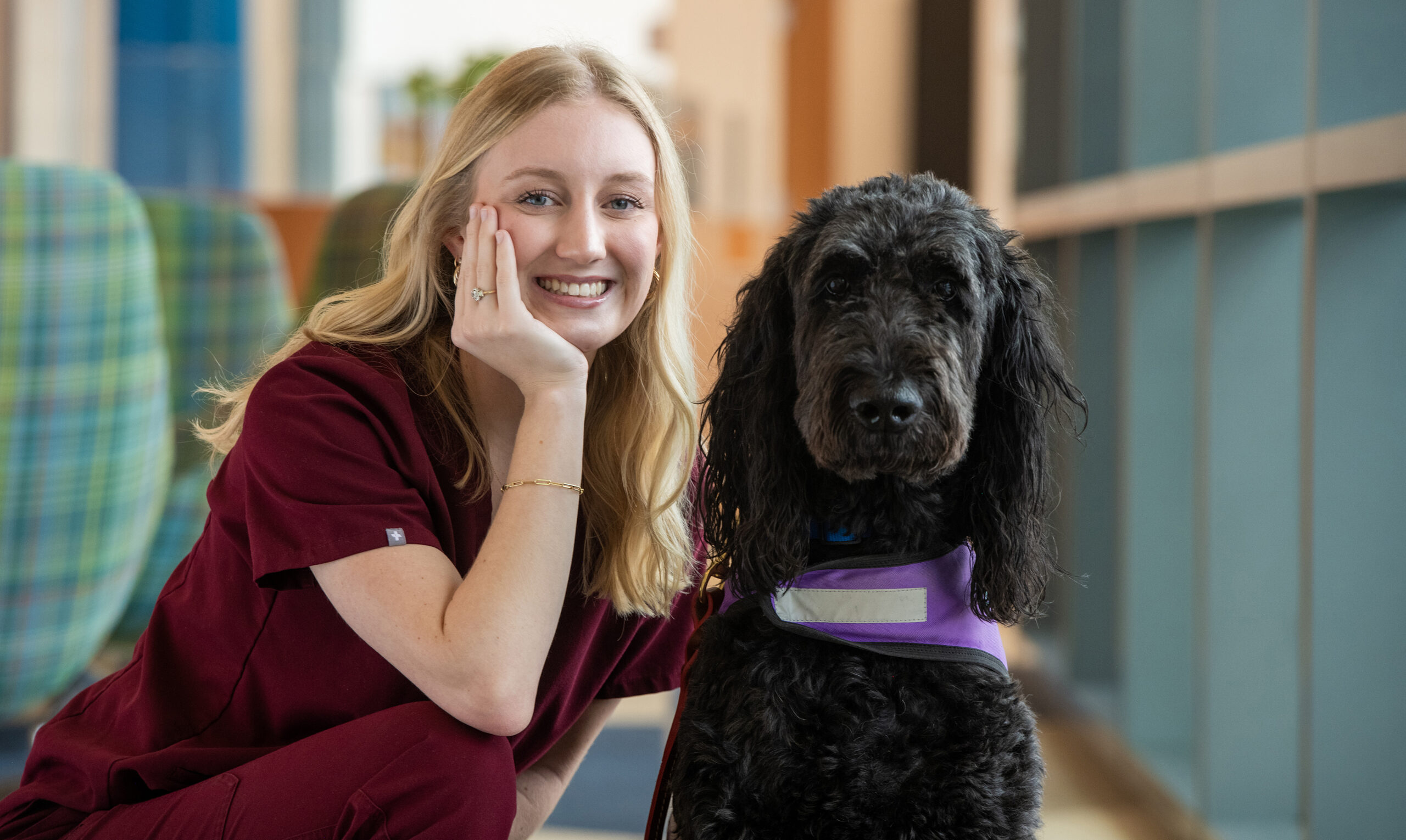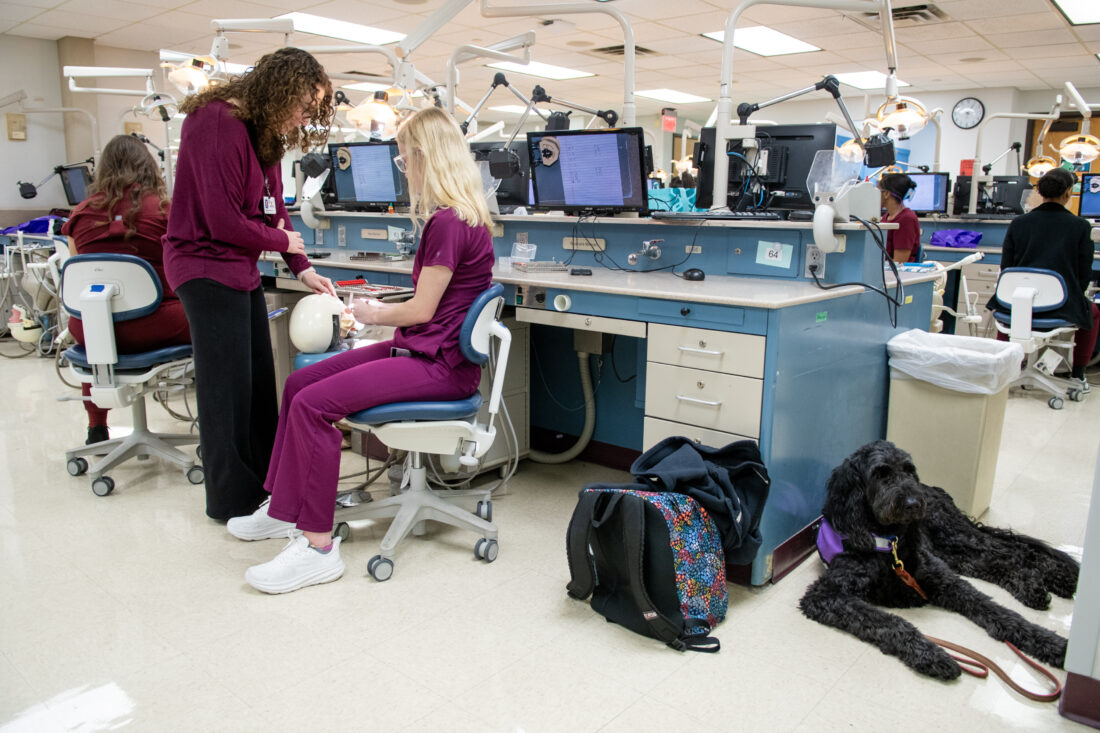In dogged pursuit

Fozzie’s eyes slowly close, and as he begins to lightly snore in the middle of a lecture, dental hygiene student Cora Owens exchanges knowing smiles with her classmates. The goldendoodle is the only student allowed to sleep during class, but he never falls asleep on the job.
Fozzie is Owens’ diabetic alert dog and the first service animal to accompany a student on campus at Texas A&M School of Dentistry. Always by her side, Fozzie graduated Valley Mills High School with Owens in 2021, accompanied her every step of the way throughout the pursuit of her associate’s degree at McClennan Community College and moved to Dallas with her this summer to enroll in dental hygiene school.
Leigh Ann Nurick, executive director of the hygiene program, said it is a privilege to have Owens and Fozzie on campus.
“Fozzie is a delight, and just seeing him brings a sense of calm for many people,” she said. “It has honestly been a wonderful challenge as an educator and student advocate to plan out how a service animal fits into all aspects of dental hygiene school. It gave me an entirely fresh perspective.”
Diabetes diagnosis
Owens, who grew up in Central Texas, always enjoyed going to the dentist as a kid and was drawn to the health care field at an early age. With a growing interest in preventive dentistry, she decided to become a dental hygienist, but the last several years required a special perseverance as she battled health problems while striving to reach her academic goals.
Owens was diagnosed with Type I diabetes when she was a freshman in high school. For months prior, she hadn’t felt well but couldn’t pinpoint the exact problem. Over the course of time, she lost weight, and she became increasingly thirsty. Although these are both known symptoms of diabetes, doctors attributed them to Owen’s age and her participation in athletics.
A week before her 15th birthday Owens felt horrible, and her mother insisted the doctor run bloodwork, which revealed Owens’ condition.
“I didn’t have time at first to process what happened,” Owens said. “I went straight from the doctor’s office, to the ER, to the ICU and then education before being released. It didn’t sink in until the night I got home; I just felt overwhelmed and scared.”
The teenager was put on insulin to manage her blood sugar and prevent various diabetic complications. Every day Owens must calculate how much insulin to take every time she eats or drinks, factoring in her level of physical activity and when she plans to sleep.
“I don’t think people realize how complicated it is,” she said. “I’m responsible for keeping myself alive every day.”
Owens wears a glucose monitor that sends alerts to her phone if her blood sugar drops, but after a couple of scares in the middle of the night, her family decided to explore additional safety measures.
“I had several low blood sugars, but even with the alert on my phone, I just wouldn’t wake up,” Owens said. “I didn’t even know diabetic alert dogs were a thing, but my mom did some research and found River’s Edge Dog Academy in College Station. She suggested us just going down and looking.”

Fozzie was the first dog they met, and Owens knew immediately that he was “the one.” She said Fozzie underwent obedience training, scent training and situational training. The two even trained together before she was able to take him home.
“Scent training is how they alert,” Owens said. “They take a cotton swab of your saliva when your blood sugar is low, put it in a vial and use that for the training. He alerts by nudging me.”
Owens said the first time Fozzie alerted her, she was perplexed because she felt fine.
“I was a little confused because I wasn’t low yet, but they can sense when it’s dropping,” she said. “And sure enough, 10 minutes later I was low. It still surprises me how smart he is.”
Although Fozzie has an important job, he’s a lot like other dogs and loves to chase his ball, go on walks and play with his squeaky toys. Owens is not his patient, but a friend. She said he’s adjusted well to life in Dallas and the routine at the dental school.
“He just lays down in class and goes to sleep, and he knows when the bell rings it’s time to get up,” she said. “A lot of times people don’t even know he’s there.”
Life on campus
Having a service dog on campus has presented challenges, but Fozzie is never unattended, always under the watchful eyes of Owens, faculty and staff. Nurick said the biggest struggle for the faculty team is “refraining from petting the sweet boy.”
“We see what he does for Cora and love him for being a brilliant, fuzzy guy with an incredible brain and responsibility,” she said.
Nurick said they remain sensitive to the fact that some patients, faculty, staff and students may not be comfortable around dogs, and they thoughtfully handle those situations as they arise.
The main challenge is infection control, she said. Nurick explained that most dental hygiene care produces aerosols, including particles and germs, and although they follow the guidelines of the Organization for Safety, Asepsis and Prevention to reduce the number of particles, some still exist. This could be a problem for Fozzie because unlike Owens, he does not wear personal protective equipment.
“Clinical Assistant Professor and Clinic Coordinator Brandy Cowen and I worked to find ways to protect Fozzie from these falling particles,” Nurick said. “He lays on a disposable pad that is thrown away after every clinic day. When aerosols are involved, we will determine if he should be covered in a disposable sheet to protect him from floating particles landing on him.”
Nurick explained this would prevent Fozzie from carrying germs home and re-exposing Owens when she’s not wearing PPE.

Dr. Jennifer Barrington, associate dean for clinical affairs, said in addition to the disposable pads and sheet for Fozzie, Owens was assigned an operatory in a low-traffic area, giving Fozzie more space.
“This gives him a place to lie near, yet out of the immediate range of aerosols produced during some patient care,” she said. “Additionally, this allows for minimal interruptions for Fozzie when on duty during the, sometimes lengthy, clinic sessions.
“Maintaining standard infection control protocols during patient care is critical,” Barrington continued. “We consistently achieved the standards before Cora and Fozzie joined us in our campus clinics and continue to do so reliably due to Fozzie’s excellent training and behavior and the diligence and dedication of Cora, fellow students, staff and faculty to achieving success.”
Owens works closely with the dental hygiene faculty to ensure Fozzie fits seamlessly into her routine. She said the biggest challenge they’ve faced so far is his size.
“His legs are so long that sometimes it’s difficult to fit him into small spaces,” she said with a laugh. “Normally people love him, and everyone comments on how calm he is.”
Although Fozzie loves head scratches, Owens said it’s best to always ask first before petting a service dog, so they’re not distracted from their work. Also, with a dog like Fozzie who is rewarded with treats when he alerts, it’s important to refrain from giving him food.
“Basically, don’t do anything without permission and be respectful of their space,” Owens said. “If people want to pet him or have a question, just ask. Everyone with a service dog might not feel this way, but I don’t mind sharing about Fozzie.”
Owens said navigating diabetes has informed her approach to treatment, raising her awareness of patients’ individual health challenges.
“Disabilities come in all shapes and sizes,” she said. “I don’t look like I need a service dog, but you never know what might be going on with someone. It’s important to remember that in day-to-day life and in the clinic as we’re treating patients.”
Owens is slated to graduate in May 2025 and hopes to return home and work in private practice with Fozzie by her side.